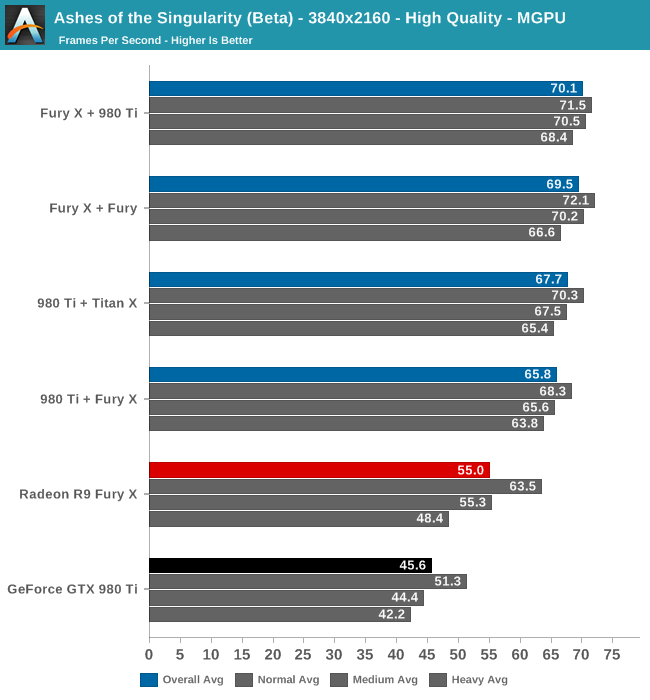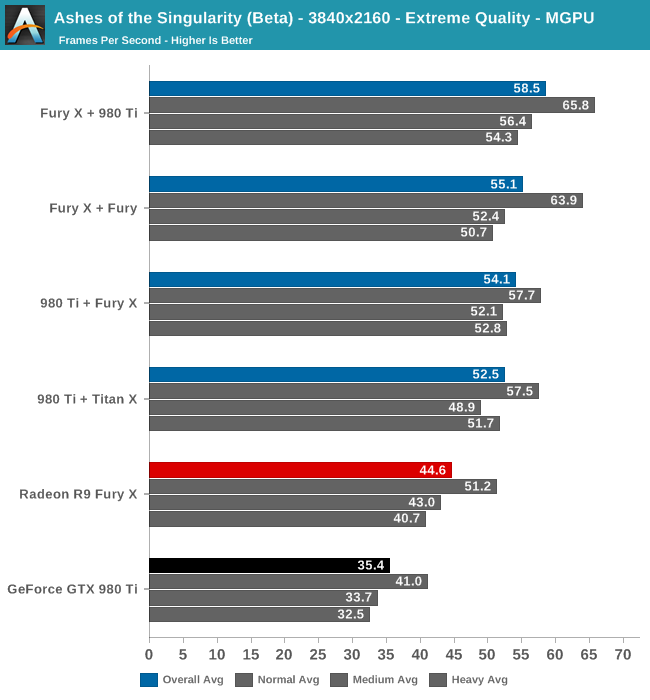Ashes of the Singularity Revisited: A Beta Look at DirectX 12 & Asynchronous Shading
by Daniel Williams & Ryan Smith on February 24, 2016 1:00 PM ESTDirectX 12 Multi-GPU Performance
Shifting gears, let’s take a look at multi-GPU performance on the latest Ashes beta. The focus of our previous article, Ashes’ support for DX12 explicit multi-GPU makes it the first game to support the ability to pair up RTG and NVIDIA GPUs in an AFR setup. Like traditional same-vendor AFR configurations, Ashes’ AFR setup works best when both GPUs are similar in performance, so although this technology does allow for some unusual cross-vendor comparisons, it does not (yet) benefit from pairing up GPUs that widely differ in performance, such as a last-generation video card with a current-generation video card. None the less, running a Radeon and a GeForce card together is an interesting sight, if only for the sheer audacity of it.
Meanwhile as a result of the significant performance optimizations between the last beta build and this latest build, this has also had an equally significant knock-on effect on mutli-GPU performance as compared to the last time we looked at the game.

Even at 4K a pair of GPUs ends up being almost too much at Ashes’ High quality setting. All four multi-GPU configurations are over 60fps, with the fastest Fury X + 980 Ti configuration nudging past 70fps. Meanwhile the lead over our two fastest single-GPU configurations is not especially great, particularly compared to the Fury X, with the Fury X + 980 Ti configuration only coming in 15fps (27%) faster than a single GPU. The all-NVIDIA comparison does fare better in this regard, but only because of GTX 980 Ti’s lower initial performance.
Digging deeper, what we find is that even at 4K we’re actually CPU limited according to the benchmark data. Across all four multi-GPU configurations, our hex-core overclocked Core i7-4960X can only setup frames at roughly 70fps, versus 100fps+ for a single-GPU configuration.

Top: Fury X. Bottom: Fury X + 980 Ti
The increased CPU load from utilizing multi-GPU is to be expected, as the CPU now needs to spend time synchronizing the GPUs and waiting on them to transfer data between each other. However dropping to 70fps means that Ashes has become a surprisingly heavy CPU test as well, and that 4K at high quality alone isn’t enough to max out our dual GPU configurations.

Cranking up the quality setting to Extreme finally gives our dual-GPU configurations enough of a workload to back off from the CPU performance cap. Once again the fastest configuration is the Fury X + 980 Ti, which lands just short of 60fps, followed by the Fury X + Fury configuration at 55.1fps. In our first look at Ashes multi-GPU scaling we found that having a Fury X card as the lead card resulted in better performance, and this has not changed for the newest beta. The Fury continues to be faster at reading data off of other cards. Still, the gap between the Fury X + 980 Ti configuration and the 980 Ti + Fury X configuration has closed some as compared to last time, and now stands at 11%.
Backing off from the CPU limit has also put the multi-GPU configurations well ahead of the single-GPU configurations. We’re now looking at upwards of a 65% performance boost versus a single GTX 980, and a smaller 31% performance boost versus a single Fury X. These are smaller gains for multi-GPU configurations than we first saw last year, but it’s also very much a consequence of Ashes’ improved performance across the board. Though we didn’t have time to test it, Ashes does have one higher quality setting – Crazy – which may drive a bit of a larger wedge between the multi-GPU configurations and the Fury X, though the overhead of synchronization will always present a roadblock.












153 Comments
View All Comments
rarson - Wednesday, February 24, 2016 - link
Yeah, because people who bought a 980 Ti are already looking to replace them...Aspiring Techie - Wednesday, February 24, 2016 - link
I'm pretty sure that Nvidia's Pascal cards will be optimized for DX12. Still, this gives AMD a slight advantage, which they need pretty badly now.testbug00 - Wednesday, February 24, 2016 - link
*laughs*Pascal is more of the same as Maxwell when it comes to gaming.
Mondozai - Thursday, February 25, 2016 - link
Pascal is heavily compute-oriented, which will affect how the gaming lineup arch will be built. Do your homework.testbug00 - Thursday, February 25, 2016 - link
Sorry, Maxwell already can support packed FP16 operations at 2x the rate of FP32 with X1.The rat of compute will be pretty much exclusive to GP100. Like how Kepler had a gaming line and GK110 for compute.
MattKa - Thursday, February 25, 2016 - link
*laughs*I'd like to borrow your crystal ball...
You lying sack of shit. Stop making things up you retarded ass face.
testbug00 - Thursday, February 25, 2016 - link
What does Pascal have over Maxwell according to Nvidia again? Bolted on FP64 units?CiccioB - Sunday, February 28, 2016 - link
I have not read anything about Pascal from nvidia outside the FP16 capabilities that are HPC oriented (deep learning).Where have you read anything about how Pascal cores/SMX/cache and memory controller are organized? Are they still using crossbar or they finally passed to a ring bus? Are caches bigger or faster? What are the ratio of cores/ROPs/TMUs? How much bandwidth for each core? How much has the compressed memory technology improved? Have cores doubled the ALUs or they have made more independent core? How much independent? Is the HW scheduler now able to preempt the graphics thread or it still can't? How many threads can it support? Is the Voxel support better and able to be used heavily in scenes to make global illumination quality difference?
I have not read anything about this points. Have you some more info about them?
Because what I could see is that at a first glance even Maxwell was not really different than Kepler. But in reality the performance were quite different in many ways.
I think you really do not know anything about what you are talking about,.
You are just expressing your desire and hopes like any other fanboy as a mirror of the frustration you have suffered all these years with the less capable AMD architecture you have been using up to now. You just hop nvidia has stopped and AMD finally made a step forward. It may be you are right. But you can't say now, nor I would going telling such stupid thing you were saying without anything as a fact.
anubis44 - Thursday, February 25, 2016 - link
I think nVidia's been caught with their pants down, and Pascal doesn't have hardware schedulers to perform async compute, either. It may be that AMD has seriously beaten them this time.anubis44 - Thursday, February 25, 2016 - link
nVidia wasn't expecting AMD to force Microsoft's hand and release DX12 so soon. I have a feeling Pascal, like Maxwell, doesn't have hardware schedulers, either. It's beginning to look like nVidia's been check-mated by AMD here.